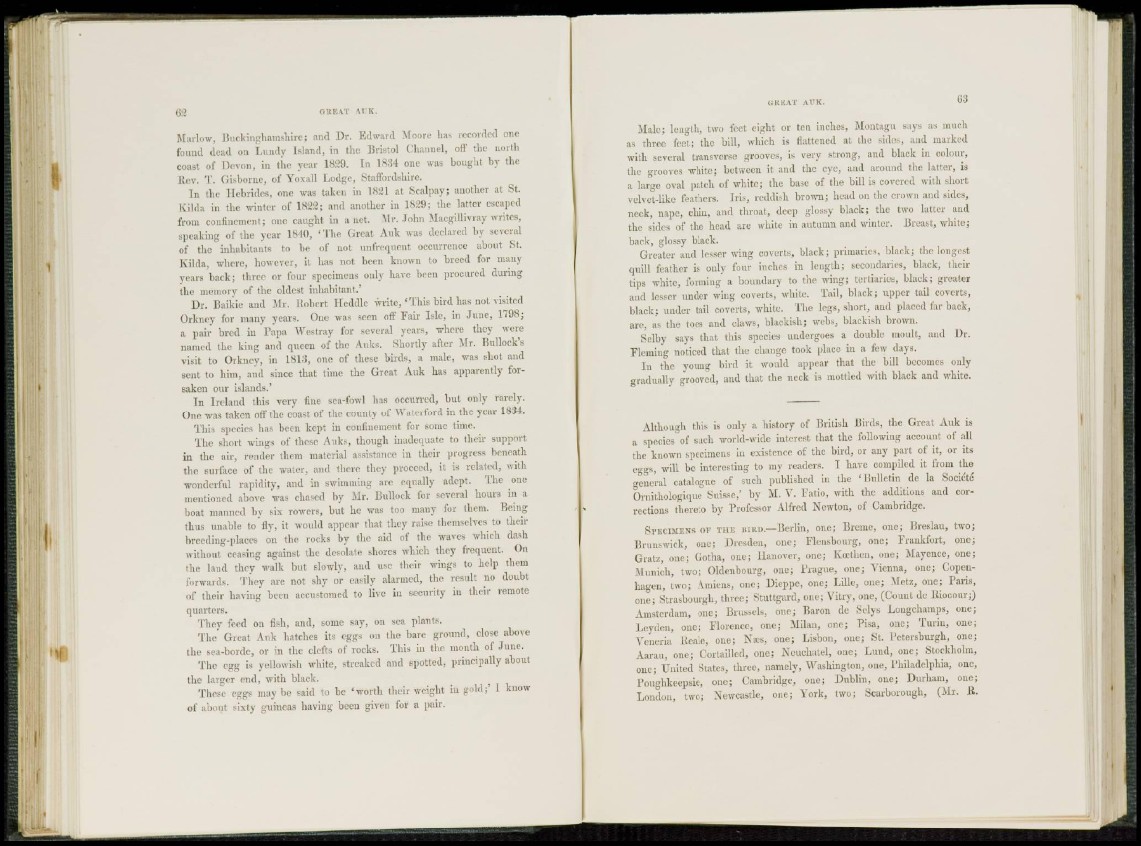
Mallow, Buckinghamshire; and Dr. Edward Moore has recorded one
found dead on I,uinly Island, in the Bristol Channel, off the north
coast of Devon, in the year 1829. In 1834 one was bought by the
Rev. T. Gisborne, of Yoxall Lodge, Staffordshire.
I n the Hebrides, one was taken in 1821 at Scalpay; another at St.
Kilda in the winter of 18^2; and another in 1829; the latter escaped
from confinement; one caught in a net. .Mr. J o h n Macgilliviay writes,
speaking of the year 1840, ' T h e Great Auk was declared by several
of the inhabitants to be of not unfrequcnt occurrence about St.
Kilda, where, however, it has not been known to breed for many
years back; three or four specimens only have been procured during
the memory of the oldest inhabitant.'
Dr. Baikie and Mr. Roberl Ileddlc w r i t e , ' T h i s bird has not visited
Orkney for many years. One was seen off Fair Isle, in June, 1798;
a pair bred in Papa Westray for several years, where they were
named the king and queen of the Auks. Shortly after Mr. Bullock's
visit to Orkney, in 1813, one of these birds, a male, was shot and
sent to him, and since that lime the Great Auk has apparently forsaken
our islands.'
I n Ireland this very fine sea-fowl has occurred, but only rarely.
One was taken off the coast of the county of Waterford in the year 1834.
This species lias been kept in confinement for some time.
The short wings of these Auks, though inadequate to their support
in the air, render them material assistance in their progress beneath
t h e surface of the water, and there they proceed, it is related, with
wonderful rapidity, and in swimming are equally adept. The one
mentioned above was chased by Mr. Bullock for several hours in a
boat manned by six rowers, but he was too many for them. Being
thus unable to fly, it would appear that they raise themselves to their
breeding-places on the rocks by the aid of the waves which dash
without ceasing against the desolate shores which they frequent. On
the land they walk but slowly, and use their wings to help them
forwards. They are not shy or easily alarmed, the result no doubt
of their having been accustomed to live in security in their remote
quarters.
They feed on fish, and, some say, on sea plants.
The Great Auk hatches its eggs on the bare ground, close above
the sea-borde, or in the clefts of rocks. This in the month of June.
The egg is yellowish white, streaked and spotted, principally about
the larger end, with black.
These eggs may be said to be 'worth their weight in gold;' I know
of about sixty guineas having beeu given for a pair.
GREAT AUK. 63
Male; length, two feet eight or ten inches, Montagu says as much
as three feet; the bill, which is flattened at. the sides, and marked
with several transverse grooves, is very strong, and black in colour,
the grooves white; between it and the eye, and around the latter, is
a large oval patch of white; the base of the bill is covered with short
velvet-like feathers. Iris, reddish brown; head on the crown and sides,
neck, nape, chin, and throat, deep glossy black; the two latter and
the sides of the head are white in autumn and winter. Breast, white;
back, glossy black.
Greater and lesser wing coverts, black; primaries, black; the longest
quill leather is only four inches in length; secondaries, black, their
tips white, forming a boundary to the wing; tertiaries, black; greater
and lesser under wing coverts, white. Tail, black; upper tail coverts,
black; under tail coverts, white. The legs, short, and placed fur back,
are, as the toes and claws, blackish; webs, blackish brown.
Selby says that this species undergoes a double moult, and Dr.
Fleming noticed that the change took place in a few days.
I n the young bird it would appear that the bill becomes only
gradually grooved, and that the neck is mottled with black and white.
Although this i, only a history of British Birds, the Great Auk is
a species of such world-wide interest that the following account of all
the known specimens in existence of the bird, or any part of it, or its
eggs, will be interesting to my readers. I have compiled it from the
general catalogue of such published in the * Bulletin de la Société
Ornithologique Suisse.' by M. V. Fatio, with the additions and corrections
thereto by Professor Alfred Newton, of Cambridge.
SPECIMENS OF T H E BIRD.—Berlin, one; Breme, one; Breslau, two;
Brunswick, one; Dresden, one; Flensbourg, one; Frankfort, one;
Gratz, one; Gotha, one; Hanover, one; Kccthen, one; Mayence, one;
Munich, two; Oldenbourg, one; Prague, one; Vienna, one; Copenhagen,
two; Amiens, one; Dieppe, one; Lille, one; Metz, one; Paris,
one; Strasbourgh, three; Stuttgard, one; Vitry, one, (Count de ltiocour;)
Amsterdam, one; Brussels, one ; Baron de Selys Longchamps, one;
1 icyden, one ; Florence, one ; Milan, one ; Pisa, one ; Turin, one ;
Veneris Keale, one ; No,'s, one ; Lisbon, one ; St. Petersburgh, one ;
Aarau, one; Cortailled, one; Neuchatel, one; Lund, one; Stockholm,
one; United States, three, namely, Washington, one, Philadelphia, one,
Poughkeepsic, one; Cambridge, one ; 1 )ublin, one; Durham, one;
London, two; Newcastle, one; York, two; Scarborough, (Mr. JR.